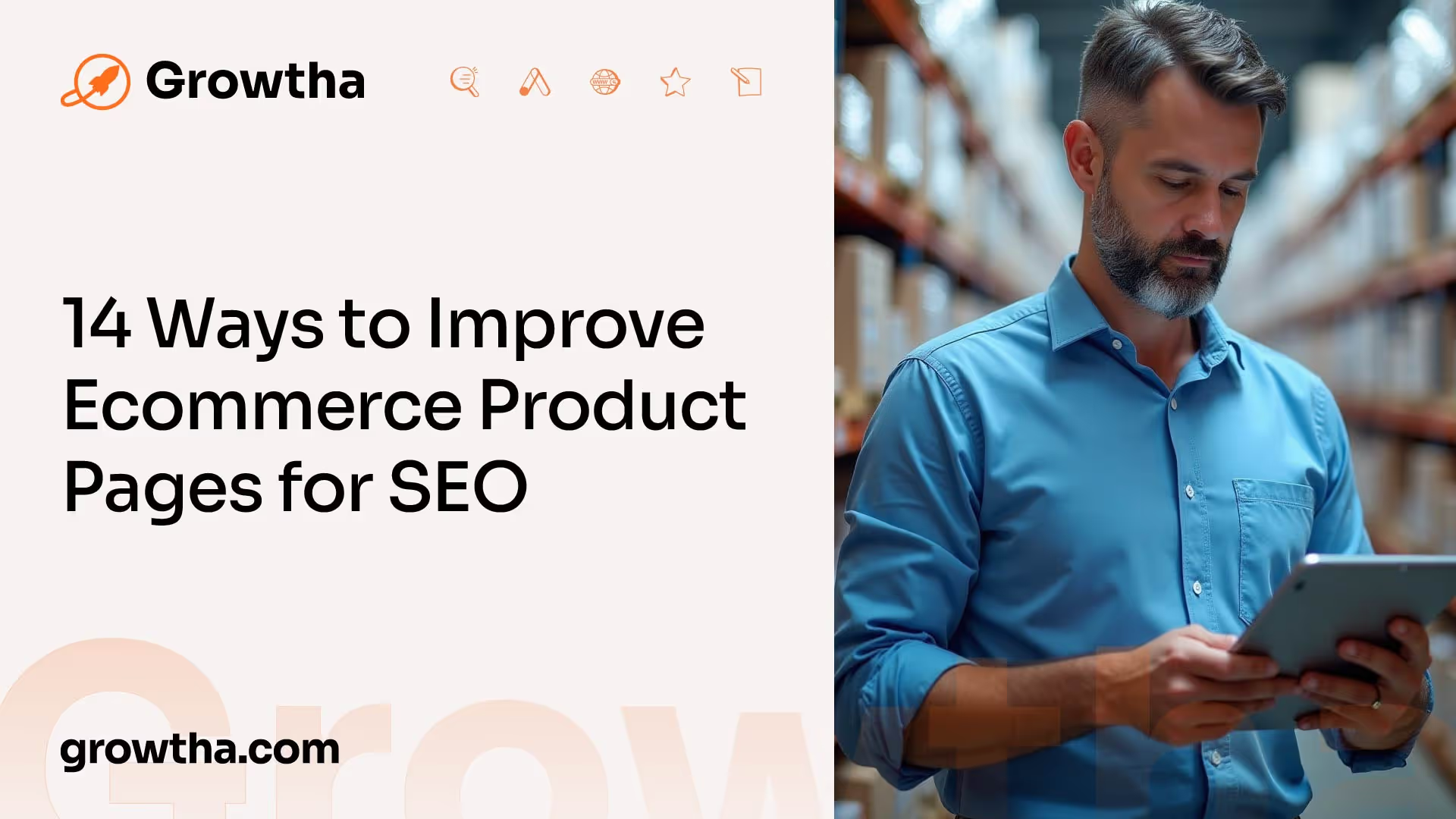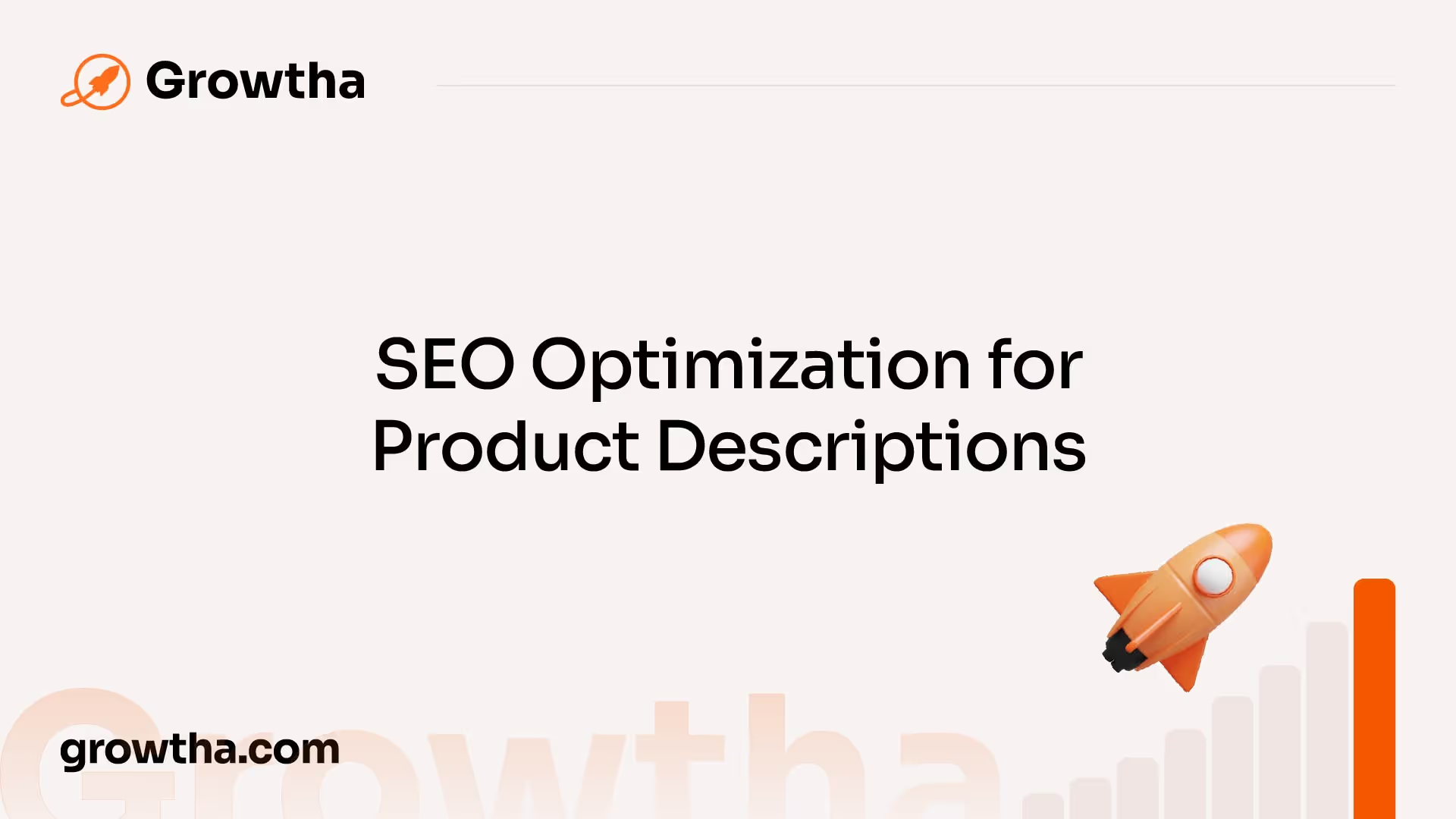14 Ways to Improve Ecommerce Product Pages for SEO
Internal linking plays a vital role in optimizing product pages for SEO.


14 Ways to Improve Ecommerce Product Pages for SEO
Internal Linking Strategies

Internal linking plays a vital role in optimizing product pages for SEO. By strategically incorporating internal links within your website, you can enhance the visibility and ranking of your product pages. This section will explore the importance of internal links and provide insights on optimizing internal link structure.
Importance of Internal Links
Internal links serve as pathways that connect different pages within your website. They are crucial for SEO as they help search engines like Google discover and index content on websites [1]. When a page receives multiple internal links, it signals to search engines that the page is important, increasing its visibility and authority.
One of the key benefits of internal links is that they establish relationships between different pieces of content. By linking relevant product pages to each other, you create a network of interconnected information that helps visitors navigate through your website and discover related products. This improves the overall user experience and encourages visitors to explore more of your offerings.
Furthermore, internal linking assists search engines in better understanding the structure and hierarchy of your website. It helps them find and index all the pages on your site, especially as it grows in size and complexity. Without internal links, certain pages may become orphaned, meaning they have no internal links pointing to them, making it difficult for search engines to discover and index them.
Optimizing Internal Link Structure

To optimize your internal link structure, consider the following strategies:
- Create Relevant Anchor Text: When incorporating internal links, use descriptive and relevant anchor text. The anchor text should provide a clear indication of what the linked page is about. This helps search engines understand the context and relevance of the linked page.
- Link to Important Pages: Identify the most important product pages on your website and ensure they receive a significant number of internal links. Distribute internal link value strategically to boost the visibility and authority of these pages.
- Utilize Menu and Navigation: Include internal links to your product pages in the main menu or navigation bar of your website. This ensures easy access to your products from every page, enhancing user experience and facilitating search engine discovery.
- Contextual Linking: Incorporate internal links within the content of your product descriptions, blog posts, and other relevant pages. These contextual links provide additional information to readers and help search engines understand the relationships between different pieces of content.
Remember that the number and quality of internal links matter. Focus on creating a network of internal links that provide value to users and improve the overall structure of your website. By implementing effective internal linking strategies, you can enhance the SEO performance of your product pages and increase their visibility in search engine rankings.
Enhancing Product Photos

When it comes to optimizing product pages for SEO, enhancing product photos plays a crucial role. The impact of product images on the overall user experience and conversion rates cannot be underestimated. High-quality and visually appealing product photos can significantly impact customer perception and drive sales. On the other hand, low-quality or poorly presented images can have the opposite effect, leading to negative reviews and damaging the brand's reputation.
Impact of Product Images
According to Storeplum, good product photos are not only visually appealing but also help build trust in your brand. They convey a sense of professionalism and attention to detail, which can have a significant impact on conversion rates. Detailed visuals, such as high-quality images, 360-degree views, and product videos, help overcome the limitations of online shopping, improve the shopping experience, and increase customer confidence in making a purchase.
Detailed and high-resolution product images allow customers to examine the product closely, providing a virtual experience that simulates the in-store shopping experience. By showcasing products from different angles and providing close-up shots, customers can get a better understanding of the product's features, texture, and quality. This level of detail helps customers make informed decisions and reduces the likelihood of product returns.
Consistency in Visual Presentation
Consistency in visual presentation across all product pages and marketing materials is paramount to brand recognition and customer retention. When customers visit your website, they should instantly recognize your brand by the visual elements presented. This includes maintaining a consistent color scheme, font, and style throughout your product pages and other marketing collateral.
By ensuring a consistent visual presentation, you create a cohesive and professional image for your brand. This helps to build trust and familiarity with your customers, enhancing their overall experience and making them more likely to return for future purchases. Consistency also reinforces your brand identity and makes it easier for customers to remember and recognize your products in a competitive market.
To optimize product photos for SEO, it is important to follow best practices for image optimization. High-quality images with descriptive file names and optimized alt text are essential for showcasing products and conveying content to search engine crawlers. This is particularly important for brands that have minimal text on their product pages, as images play a crucial role in conveying information to both customers and search engines [2].
In conclusion, enhancing product photos is a powerful way to optimize product pages for SEO. By utilizing high-quality and visually appealing images, you can enhance brand reputation, improve customer loyalty, and increase conversion rates. Additionally, maintaining consistency in visual presentation helps in brand recognition and customer retention. Remember to optimize your product images for search engines by using descriptive file names and alt text. By implementing these strategies, you can create a compelling and engaging shopping experience for your customers.
SEO Optimization for Product Descriptions

Product descriptions play a crucial role in optimizing e-commerce product pages for SEO. By implementing effective strategies, such as focusing on the ideal length and incorporating relevant keywords, you can enhance the visibility and searchability of your products.
Ideal Length for Product Descriptions
When it comes to the length of product descriptions, there is no one-size-fits-all answer. However, most SEO and marketing experts suggest aiming for 300 to 400 words for each product description. This range provides enough space to convey important information while keeping the description concise and engaging [3].
It's important to note that the actual length of the product description should be determined by the complexity of the product and the need to provide sufficient information to the reader. Some products may require a more detailed description to explain its features, benefits, and usage instructions. On the other hand, simpler products may require a shorter description that highlights key selling points.
To optimize the length of your product descriptions, consider the buyer's awareness level. For products targeting customers in the awareness stage, provide more detailed information to educate and generate interest. For products targeting customers in the decision stage, focus on highlighting the unique selling points and benefits to drive conversions.
Importance of Relevant Keywords
Using relevant keywords throughout your product descriptions is crucial for improving the chances of ranking higher in search engine results pages (SERPs) and driving organic traffic to your store [3]. Conduct thorough keyword research to identify the terms and phrases your target audience is using to search for products similar to yours. Incorporate these keywords strategically into your product descriptions.
When incorporating keywords, it's important to write for buyers rather than solely for search engines. Create compelling and informative descriptions that naturally include keywords without compromising readability. Avoid keyword stuffing, which can negatively impact the user experience and your search rankings.
Strategically place keywords in the copy, including the product title, headings, and throughout the description. Focus on long-tail keywords that are specific to your product and have lower competition. Long-tail keywords often have higher conversion rates since they target users who are closer to making a purchase decision.
Remember to create unique product descriptions for each product page to avoid duplicate content issues. Unique descriptions not only provide valuable information to potential customers but also help search engines understand the uniqueness and relevance of your products.
By optimizing the length of your product descriptions and incorporating relevant keywords, you can improve the SEO performance of your e-commerce product pages. These strategies will not only make your products more discoverable but also provide valuable information to potential customers, ultimately driving conversions and boosting your e-commerce success.
Leveraging User-Generated Content

When it comes to optimizing your e-commerce product pages for SEO, leveraging user-generated content can be a powerful strategy. User-generated content, such as product reviews and FAQs, not only enhances the overall user experience but also provides numerous SEO benefits.
Benefits of Product Reviews
Product reviews are valuable user-generated content that can significantly impact your e-commerce site's SEO ranking and overall performance. Positive reviews contribute to Google's E-A-T (Expertise, Authority, and Trustworthiness) guidelines, which are essential factors in search engine algorithms. A high volume of positive reviews demonstrates to Google that your site is a trusted and authoritative source, leading to improved search engine rankings [4].
In addition to improving your SEO ranking, product reviews can also increase your click-through rate. When potential customers see positive reviews from real users, they are more likely to trust your product and click through to your website. This increased click-through rate can drive more organic traffic to your e-commerce site and potentially result in higher conversions.
Furthermore, product reviews contribute to the authority and trustworthiness of your e-commerce site. When customers see that others have had positive experiences with your products, they are more likely to trust your brand and make a purchase. Building trust and authority can lead to long-term customer loyalty and repeat business.
Incorporating FAQs on Product Pages
In addition to product reviews, incorporating frequently asked questions (FAQs) on your product pages can also enhance the SEO optimization of your e-commerce site. FAQs provide valuable information that potential customers may be searching for, and search engines favor fresh and relevant content.
By including FAQs on your product pages, you can address common customer queries and provide detailed information about your products. This not only helps potential customers make informed purchasing decisions but also provides search engines with additional content to index. When search engines see that your product pages contain relevant and helpful information, they are more likely to rank your site higher in search results [2].
When creating FAQs for your product pages, consider the specific questions that potential customers may have about your products. Be thorough in your answers and provide detailed information to address any concerns or doubts. By providing comprehensive and accurate information, you can increase customer trust and engagement.
Incorporating user-generated content like product reviews and FAQs into your e-commerce product pages not only improves the user experience but also has a positive impact on your SEO. By encouraging customers to share their experiences through reviews and addressing common questions through FAQs, you can enhance your authority, trustworthiness, and search engine ranking. Remember, the goal is to provide valuable and relevant content that helps customers make informed purchasing decisions while boosting your e-commerce success.
Advanced Product Page Optimization
To take your e-commerce success to the next level, advanced optimization techniques for your product pages can make a significant impact. Two key strategies to consider are structured data implementation and the strategic use of power words.
Structured Data Implementation
Implementing structured data on your product pages can provide search engines with additional details about your products, such as prices, availability, brand names, and reviews. This extra information can enhance the visibility of your products in search engine results and potentially increase click-through rates. By attracting more qualified traffic to your store, structured data implementation can positively impact your SEO efforts [3].
Structured data can be added to your product pages using schema markup, a standardized format that search engines understand. By including relevant schema markup for product information, you can provide clear and organized details that search engines can easily interpret. This can lead to improved visibility and better ranking in relevant search results.
Strategic Use of Power Words
Power words, also known as "trigger words," are persuasive terms that evoke emotions and grab the attention of your website visitors. When strategically incorporated into your product descriptions, power words can inspire action and boost conversion rates. Additionally, power words can potentially have a positive impact on your search engine ranking by increasing user engagement and click-through rates [3].
Consider using power words that are relevant to your products and align with your brand's messaging. Words such as "exclusive," "limited edition," "premium," and "guaranteed" can create a sense of urgency, exclusivity, and trust. Experimenting with different power words and monitoring their impact on user behavior can help you identify the most effective ones for your target audience.
Remember to use power words sparingly and with intention. Overusing them may come across as spammy or insincere, which can have a negative impact on user experience and your brand reputation. Strive for a balance between persuasive language and clear, concise product descriptions.
By implementing structured data and strategically incorporating power words into your product pages, you can optimize your e-commerce site for improved SEO performance. These advanced techniques can help attract more qualified traffic, increase user engagement, and ultimately drive higher conversion rates. Stay on top of the latest developments in SEO and continue testing and refining your optimization strategies to stay ahead of the competition.
Global Adaptation of Product Pages
To achieve success in the global marketplace, it is essential to adapt product pages for a diverse range of customers worldwide. This process involves more than just translation; it requires a multifaceted approach to ensure that product pages are useful, engaging, and optimized for search engines.
Importance of Multifaceted Approach
Global adaptation of product pages goes beyond simply translating the content. It involves understanding the cultural nuances, preferences, and expectations of different target markets. By taking a multifaceted approach, businesses can create product pages that resonate with their international audience [2].
When adapting product pages for global markets, consider the following aspects:
- Localization: Translate product descriptions, titles, and other relevant information into the local language to provide a seamless browsing experience for users. Ensure that the translations are accurate and culturally appropriate.
- Currency and Pricing: Display product prices in the local currency to facilitate ease of understanding and comparison. Take into account exchange rates and local pricing dynamics to ensure competitive pricing in each market.
- Measurement Units: Adjust measurement units (e.g., inches to centimeters, pounds to kilograms) to align with the local standards and make it easier for customers to comprehend product dimensions and specifications.
- Shipping and Delivery: Clearly communicate shipping options, delivery times, and any associated costs in a way that is relevant to each market. Consider local shipping partners and customs regulations to provide accurate information to customers.
- Payment Methods: Offer a variety of payment methods that are popular and trusted in each target market. This ensures convenience and instills confidence in customers during the checkout process.
By addressing these factors, businesses can enhance the user experience, build trust, and improve their chances of success in international markets.
Engaging Users Worldwide
Engaging users worldwide requires careful consideration of their unique needs and preferences. Here are some strategies to create engaging product pages for a global audience:
- High-Quality Product Content: Provide comprehensive and accurate information about the product, including detailed descriptions, specifications, pricing, and images. This helps customers make informed purchase decisions [5].
- User-Generated Content: Encourage customers to leave reviews and ratings for products. These user-generated reviews provide valuable insights into product quality, performance, and customer satisfaction. Incorporating product ratings and reviews into product pages can influence purchasing decisions.
- Personalization: Tailor the product page experience based on the user's location, language, and browsing history. This can include displaying relevant product recommendations, local promotions, and personalized content to enhance engagement.
- Mobile Optimization: Optimize product pages for mobile devices, as mobile shopping continues to grow globally. Ensure that the layout, images, and information are displayed effectively on smaller screens.
By implementing these strategies, businesses can create product pages that resonate with users worldwide, leading to increased engagement, conversions, and overall success in the global marketplace.
References
[1]: https://yoast.com/internal-linking-for-seo-why-and-how/
[2]: https://searchengineland.com/product-page-seo-guide-437261
[3]: https://www.seoptimer.com/blog/seo-product-descriptions/
[4]: https://www.linkedin.com/advice/1/how-do-product-reviews-boost-your-seo-ranking-traffic/
[5]: https://www.bigcommerce.com/articles/ecommerce/product-page-examples/
[6]: https://getflowbox.com/blog/product-ratings-and-product-reviews/







